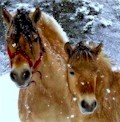The English-speaking world measures the height of horses in hands, abbreviated "h" or "hh", and is measured at the highest point of an animal's withers. One hand is 4 inches or 10.16 cm. Intermediate heights are defined by hands and inches rounded to the lower measurement in hands, followed by a decimal point and the number of additional inches between 1 and 3. Thus a horse described as 15.2 hh tall means it is 15 hands 2 inches (62 inches or 1.57 meters) in height. The size of horses varies by breed but can also be influenced by nutrition. The general rule for cutoff in height between what is considered a horse and a pony at maturity is 14.2 hand (58 inches or 147 cm) as measured at the withers. An animal 14.2 h or over is considered a horse and one less than 14.2 h is a pony.
Horse DigestionA horse is an herbivore with a digestive system adapted to a forage diet of grasses and other plant material, consumed regularly throughout the day, and so they have a relatively small stomach and very long intestines to facilitate a steady flow of nutrients. A 1,000 pound horse will eat between 15-25 pounds (7-11 kg) of food per day and, under normal use, drink 10-12 gallons (38-45 liters) of water.
Horse HoovesThe crucial importance of the feet and legs is summed up by the traditional adage, "no foot, no horse." The horse hoof begins with the distal phalanges, the equivalent of the human fingertip or tip of the toe, surrounded by cartilage and other specialized, blood-rich soft tissues such as the laminae, with the exterior hoof wall and horn of the sole made of the same material as human fingernails. The end result is that a horse weighing an average 1,000 pounds travels on the same bones as a human on tiptoe. For the protection of the hoof under certain conditions, some horses have horseshoes placed on their feet by a professional farrier. The hoof continually grows, just like a large fingernail, and needs to be trimmed every six to eight weeks and horseshoes reset.
Horse SensesThe senses of a horse are generally superior to those of a human. As prey animals, they must be aware of their surroundings at all times. They have very large eyes with excellent day and night vision, though they may have a limited range of color vision. The side positioning of the eyes gives the horse a wide field of vision of about 350 degrees. While not color-blind, studies indicate that they have difficulty distinguishing greens, browns, and grays. Their hearing is good and the pinna of their ears can rotate a full 360 degrees in order to pick up sound from any direction. Their sense of smell, while much better than that of humans, is not their strongest asset. They rely to a greater extent on vision.
A horse’s sense of balance is outstanding, the cerebellum of their brain is highly developed, and they are very aware of terrain and placement of their feet. Horses’ sense of touch is better developed than many people think, they immediately notice when a fly or mosquito lands on them, even before the insect attempts to bite. Their sense of taste is well developed in order to determine the nature of the plants they are eating, and their prehensile lips can easily sort even the smallest grains. Horses will seldom eat most poisonous plants or spoiled food unless they have no other choice.
Horse GaitsAll horses move naturally with four basic gaits: the walk, trot or jog, canter or lope, and gallop.
